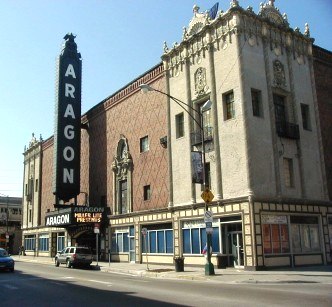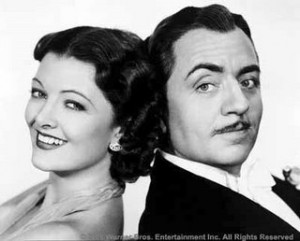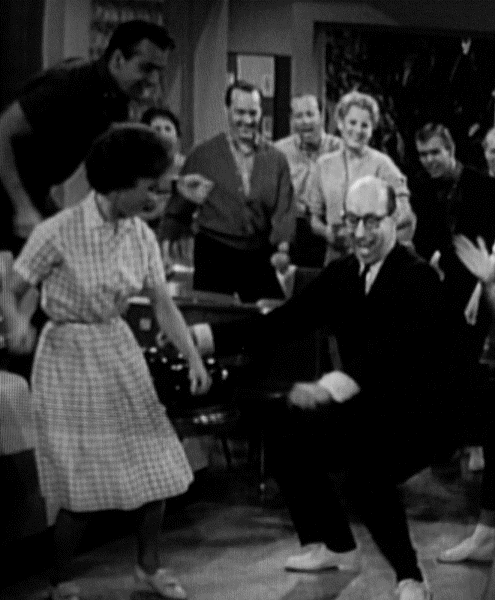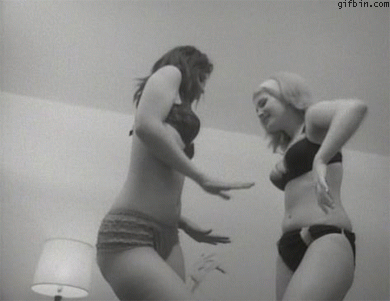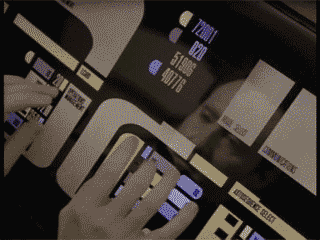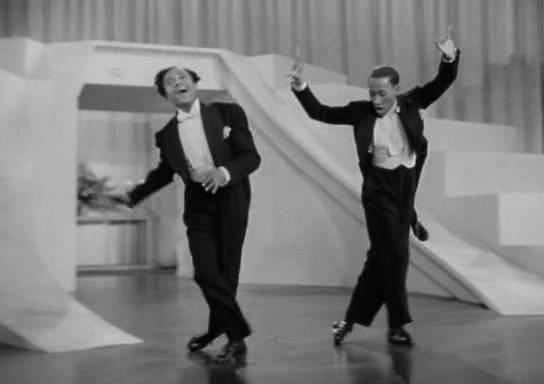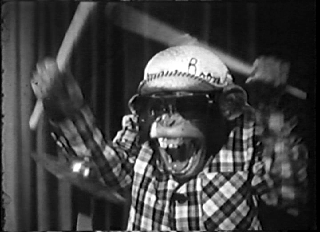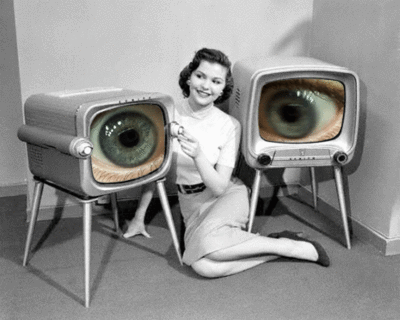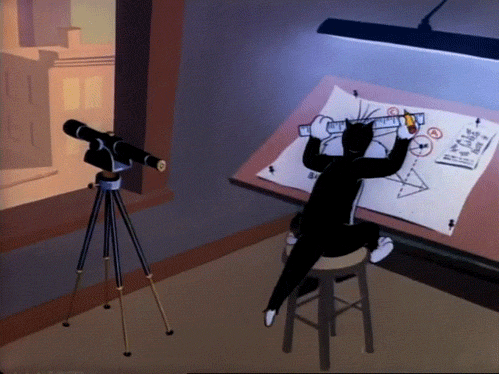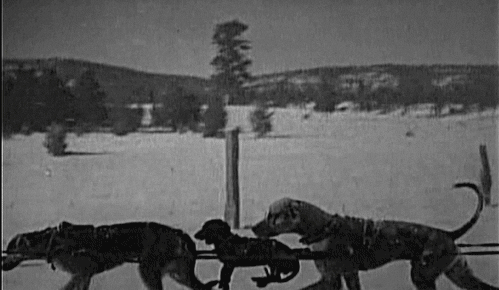I just saw the above photo online. Interesting....I was just in my kitchen a few moments before and here is a cardboard advert from the same series that's on my wall......just thought it was cool to post them both. I'd never seen the photo or other advertising from this particular ad campaign, other than my cardboard sign :)
Search This Blog
Tuesday, November 29, 2011
Because the more things change.....well, ya know the rest. Same complaints, different year......
Aren't we supposed to repeat history when we're ignorant of it? sigh***....sadly we don't have a "New Deal"....any Deal at all. Just the bad hand we're being dealt from all sides, I suppose.....
Monday, November 28, 2011
Todays OTR: Dick Jurgens at the Aragon Ballroom-Chicago Ausust 12, 1950 CBS-WBBM
A nice smooth one today....Chicago's Aragon Ballroom....August 12, 1950...The very danceable Dick Jurgens Orch....A full 30 min. of remote broadcast on CBS/WBBM. Enjoy.
The Aragon Ballroom (1106 West Lawrence Avenue) opened its doors in July 1926 and quickly became a center of dance-hall culture in Chicago. Designed by Huszagh & Hill, the interior lavishly recreates a Mediterranean plaza, its arcades surrounding a huge dance floor suspended on a system of springs, cork, and felt.
Located in Uptown, alongside the “L,” it drew dancers from across Chicago and the suburbs. In 1927, WGN began live broadcasts from the ballroom, spreading its fame nationwide. Tens of thousands came to the Aragon every week.
After the decline of social dancing in the 1960s, the Aragon survived by hosting rock concerts and other public events. With the recent popularity of salsa and swing, however, the Aragon is again becoming a destination for dancers.
The Aragon today....
The beautiful Aragon Ballroom, on Chicago's North Side...Lawrence Avenue near Broadway...famous everywhere for featuring the finest in music and dancing...in perfect. air-conditioned comfort. :)
Labels:
Dick Jurgens,
OTR,
radio
Sunday, November 27, 2011
Enough velvet to make a dress for 20 fat women...Part one....Early Mel Tormé ;)
"Tormé works with the most beautiful voice a man is allowed to have, and he combines it with a flawless sense of pitch… As an improviser he shames all but two or three other scat singers and quite a few horn players as well" -—Will Friedwald, Jazz Singing
Melvin Howard Tormé (September 13, 1925 – June 5, 1999), nicknamed The Velvet Fog, was an American musician, known for his jazz singing. He was also a jazz composer and arranger, a drummer, an actor in radio, film, and television, and the author of five books. He composed the music for the classic holiday song "The Christmas Song" ("Chestnuts Roasting on an Open Fire") and co-wrote the lyrics with Bob Wells.
Melvin Howard Tormé was born in Chicago, Illinois, to immigrant Russian Jewish parents, whose surname had been Torma. However, the name was changed at Ellis Island to "Torme." A child prodigy, he first sang professionally at age 4 with the Coon-Sanders Orchestra, singing "You're Driving Me Crazy" at Chicago's Blackhawk restaurant.
Between 1933 and 1941, he acted in the network radio serials The Romance of Helen Trent and Jack Armstrong, the All-American Boy. He wrote his first song at 13, and three years later, his first published song, "Lament to Love," became a hit recording for Harry James. He played drums in Chicago's Shakespeare Elementary School drum and bugle corps in his early teens. While a teenager, he sang, arranged, and played drums in a band led by Chico Marx of the Marx Brothers. His formal education ended in 1944 with his graduation from Chicago's Hyde Park High School.
In 1943, Tormé made his movie debut in Frank Sinatra's first film, the musical Higher and Higher. He went on to sing and act in many films and television episodes throughout his career, even hosting his own television show in 1951–52. His appearance in the 1947 film musical Good News made him a teen idol for a few years.
In 1944 he formed the vocal quintet "Mel Tormé and His Mel-Tones," modeled on Frank Sinatra and The Pied Pipers. The Mel-Tones, which included Les Baxter and Ginny O'Connor, had several hits fronting Artie Shaw's band and on their own, including Cole Porter's "What Is This Thing Called Love?" The Mel-Tones were among the first jazz-influenced vocal groups, blazing a path later followed by The Hi-Lo's, The Four Freshmen, and The Manhattan Transfer.
Later in 1947, Tormé went solo. His singing at New York's Copacabana led a local disc jockey, Fred Robbins, to give him the nickname "The Velvet Fog," thinking to honor his high tenor and smooth vocal style, but Tormé detested the nickname. (He self-deprecatingly referred to it as "this Velvet Frog voice".[citation needed]) As a solo singer, he recorded several romantic hits for Decca (1945), and with the Artie Shaw Orchestra on the Musicraft label (1946–48). In 1949, he moved to Capitol Records, where his first record, "Careless Hands," became his only number one hit. His versions of "Again" and "Blue Moon" became signature tunes. His composition "California Suite," prompted by Gordon Jenkins' "Manhattan Tower," became Capitol's first 12-inch LP album. Around this time, he helped pioneer cool jazz.
From 1955 to 1957, Tormé recorded seven jazz vocal albums for Red Clyde's Bethlehem Records, all with groups led by Marty Paich, most notably Mel Tormé with the Marty Paich Dektette. When rock and roll music (which Tormé called "three-chord manure") came on the scene in the 1950s, commercial success became elusive. During the next two decades, Tormé often recorded mediocre arrangements of the pop tunes of the day, never staying long with any particular label. He was sometimes forced to make his living by singing in obscure clubs. He had two minor hits, his 1956 recording of "Mountain Greenery," which did better in the United Kingdom where it reached #4 in May that year; and his 1962 R&B song "Comin' Home, Baby," arranged by Claus Ogerman. The latter recording led the jazz and gospel singer Ethel Waters to say that "Tormé is the only white man who sings with the soul of a black man." It was later covered instrumentally by Quincy Jones and Kai Winding.
In 1960, he appeared with Don Dubbins in the episode "The Junket" in NBC's short-lived crime drama Dan Raven, starring Skip Homeier and set on the Sunset Strip of West Hollywood. He also had a significant role in a cross-cultural western entitled Walk Like a Dragon staring Jack Lord. Tormé played 'The Deacon', a bible-quoting gunfighter who worked as an enforcer for a lady saloon-owner and teaches a young Chinese, played by James Shigeta, the art of the fast draw. In one scene, he tells a soon-to-be victim: 'Say your prayers, brother Masters. You're a corpse.' And then delivers on the promise. Tormé, like Sammy Davis Jr. and Robert Fuller was a real-life fast-draw expert. He also sang the title song.
In 1963–64, Tormé wrote songs and musical arrangements for The Judy Garland Show, where he made three guest appearances. However, he and Garland had a serious falling out, and he was fired from the series, which was canceled by CBS not long afterward. A few years later, after Garland's death, his time with her show became the subject of his first book, "The Other Side of the Rainbow with Judy Garland on the Dawn Patrol" (1970). Although the book was praised, some felt it painted an unflattering picture of Judy, and that Tormé had perhaps over-inflated his own contributions to the program; it led to an unsuccessful lawsuit by Garland's family.
Tormé befriended Buddy Rich, the day Rich left the Marine Corps in 1942. Rich became the subject of Tormé's book Traps — The Drum Wonder: The Life of Buddy Rich (1987). Tormé also owned and played a drum set that drummer Gene Krupa used for many years. George Spink, treasurer of the Jazz Institute of Chicago from 1978 to 1981, recalled that Tormé played this drum set at the 1979 Chicago Jazz Festival with Benny Goodman on the classic "Sing, Sing, Sing."[3] Tormé had a deep appreciation for classical music; especially that of Frederick Delius and Percy Grainger.
The resurgence of vocal jazz in the 1970s resulted in another artistically fertile period for Tormé, whose live performances during the 1960s and 1970s fueled a growing reputation as a jazz singer. He found himself performing as often as 200 times a year around the globe. In 1976, he won an Edison Award (the Dutch equivalent of the Grammy) for best male singer, and a Down Beat award for best male jazz singer.[citation needed] For several years around this time, his September appearances at Michael's Pub on the Upper East Side would unofficially open New York's fall cabaret season. Tormé viewed his 1977 Carnegie Hall concert with George Shearing and Gerry Mulligan as a turning point. Shearing later said:
"It is impossible to imagine a more compatible musical partner… I humbly put forth that Mel and I had the best musical marriage in many a year. We literally breathed together during our countless performances. As Mel put it, we were two bodies of one musical mind."Starting in 1982, Tormé recorded several albums with Concord Records, including:
- Five albums with pianist George Shearing;
- His big band work with Rob McConnell and his Boss Brass orchestra (see Mel Tormé, Rob McConnell and the Boss Brass);
- A reunion with Marty Paich, resulting in a live recording in Tokyo (In Concert Tokyo) and a studio album (Reunion).
In 1993, Verve Records released the classic "Blue Moon" album featuring the Velvet voice and the Rodgers and Hart Songbook. His version of Blue Moon performed live at the "Sands" in November that year earned him a new nickname from older audiences: "The Blue Fox." The nickname was used to describe Tormé's performance after spending an extra hour with pianist Bill Butler cracking jokes and answering queries from a throng of more "mature" women who turned out to see the show. Under the shimmering blue lights at the Sands, he gained a new nickname that would endure for every future performance in Las Vegas and his last performance at Carnegie Hall. Tormé would develop other nicknames later in life, but none seemed as popular as the Velvet Fog (primarily on the East Coast) and the Blue Fox.[citation needed]
Tormé made nine guest appearances as himself on the 1980s situation comedy Night Court whose main character, Judge Harry Stone (played by Harry Anderson), was depicted as an unabashed Tormé fan (an admiration that Anderson shared in real-life; Anderson would later deliver the eulogy at Tormé's funeral) which led to a following among Generation Xers along with a series of Mountain Dew commercials and on an episode of the sitcom Seinfeld ("The Jimmy"), in which he dedicates a song to the character Kramer. Tormé also recorded a version of Nat King Cole's "Straighten up and Fly Right" with his son, alternative/adult contemporary/jazz singer Steve March Tormé.[citation needed] Tormé was also able to work with his other son, television writer-producer Tracy Tormé on Sliders. The 1996 episode, entitled "Greatfellas," sees Tormé playing an alternate version of himself: a country-and-western singer who is also an FBI informant.[citation needed]
In a scene in the 1988 Warner Bros. cartoon Night of the Living Duck, Daffy Duck has to sing in front of several monsters, but lacks a good singing voice. So, he inhales a substance called "Eau de Tormé" and sings like Mel Tormé (who in fact provided the voice during this one scene, while Mel Blanc provided Daffy's voice during most of the cartoon).[citation needed]
On August 8, 1996, a stroke abruptly ended his 65-year singing career. In February 1999, Tormé was awarded the Grammy Lifetime Achievement Award. Another stroke in 1999 ended his life. In his eulogistic essay, John Andrews wrote about Tormé:[4]
"Tormé's style shared much with that of his idol, Ella Fitzgerald. Both were firmly rooted in the foundation of the swing era, but both seemed able to incorporate bebop innovations to keep their performances sounding fresh and contemporary. Like Sinatra, they sang with perfect diction and brought out the emotional content of the lyrics through subtle alterations of phrasing and harmony. Ballads were characterized by paraphrasing of the original melody which always seemed tasteful, appropriate and respectful to the vision of the songwriter. Unlike Sinatra, both Fitzgerald and Tormé were likely to cut loose during a swinging up-tempo number with several scat choruses, using their voices without words to improvise a solo like a brass or reed instrument."Tormé also made a guest vocal appearance on the 1983 album Born to Laugh at Tornadoes from the progressive pop band Was (Not Was). Tormé sang the black comedic cocktail jazz song "Zaz Turned Blue" about a teenager who is choked in a park ("Steve squeezed his neck/He figured what the heck") and who may or may not have suffered brain damage as a result ("Now he plays lots of pool/And as a rule/He wears a silly grin/On his chin").
Tormé's other books include My Singing Teachers: Reflections on Singing Popular Music (1994), a biography of Buddy Rich, Traps, the Drum Wonder (1997), and his autobiography It Wasn't All Velvet (1988). He also published the novel Wynner in 1977.
Tormé wrote more than 250 songs, several of which became jazz standards. He also often wrote the arrangements for the songs he sang. He often collaborated with Bob Wells, and the best known Tormé-Wells song is "The Christmas Song," often referred to by its opening line "Chestnuts roasting on an open fire." The song was recorded first by Nat King Cole. Tormé said that he wrote the music to the song in only 40 minutes, and that it was not one of his personal favorites.
When only the very best will do.........Mel. ;)
(ah, the apple trees) when the world was young
A Bunch Of The Blues - Keester Parade - TNT - Tiny's Blues
Adios
Again
All Of You
And So To Bed
Anniversary Song
Anything goes
Anywhere I Wander
April In Paris
April showers
At The Crossroads (Malaguena)
Autumn in New York
Autumn Leaves
Baia
Baubles, Bangles And Beads
Bernie's Tune
Between the devil and the deep blue sea
Bewitched
Blue Moon (2)
Blue Moon
Blue room
Blue Skies
Blues In The Night
Body And Soul
Born To Be Blue
Broadway
The Anything Can Happen Mambo
The Blues (2)
The Blues
The Brooklyn Bridge
http://www.megaupload.com/?d=CUDD4KM5
Labels:
mel torme
Saturday, November 26, 2011
Doris Day 1944-1950 Part 1.........
Doris Day Part 1.....1944-1950
Songs by Doris and Les Brown Orch., unless otherwise noted
Sentimental Journey-20 Nov 1944
Sentimental Journey (alt vers)-1944
He's Home for a Little While-1 Feb 1945
My Dreams Are Getting Better All the Time-1 Feb 1945
I'll Always Be with You-7 Feb 1945
'Tain't Me-7 Feb 1945
Till the End of Time-17 May 1945
He'll Have to Cross the Atlantic-17 May 1945
The Last Time I Saw You-15 Sept 1945
Aren't You Glad You're You-15 Sept 1945
You Won't Be Satisfied (Until You Break My Heart)-5 Nov 1945
Come to Baby, Do!-5 Nov 1945
We'll Be Together Again-5 Nov 1945
A Red Kiss on a Blue Letter-7 Feb 1945
Day by Day-1945
In the Moon Mist-16 Jan 1946
(Ah Yes) There's Good Blues Tonight-25 Feb 1946
I Got the Sun in the Morning-25 Feb 1946
All through the Day-6 March 1946
The Whole World is Singing My Song-20 Jun 1946
Sooner or later-28 Aug 1946
The Christmas song-29 Aug 1946
My Number One Dream Came True-29 Aug 1946
You should have told me-20 Aug 1946
The Deevil, Devil, Divil-27 Mar 1946
I'd Rather Be with You-17 May 1945
http://www.megaupload.com/?d=E8ZA9OYG
Yeah, baby...Itzza Michigan thang....Early Bob Seger...1965-1972 Part 1
Bob Seger
Robert Clark "Bob" Seger (born May 6, 1945) is an American rock and roll singer-songwriter, guitarist and pianist.
Bob Seger was born in Dearborn, Michigan to Stewart and Charlotte Seger, and lived in the area until age 6 when his family moved to nearby Ann Arbor, Michigan. His father, a medical technician for the Ford Motor Company, played several instruments and Seger was exposed to music from an early age. Seger was also exposed to frequent arguments between his parents that disturbed the neighborhood at night. In 1956, when Seger was 10 years old, his father abandoned the family and moved to California. The remaining family soon lost their comfortable middle-class status and struggled financially.
Seger attended Tappan Junior High School (now Tappan Middle School) and graduated from Pioneer High School in 1963. He ran track and field in high school. Seger also went to Lincoln Park High School for a year.
Seger has stated that the first musicians "that really got to me" were Little Richard and Elvis Presley. "Come Go With Me" by The Del Vikings, a hit in 1957, was the first record he bought.
Bob Seger arrived on the Detroit music scene in 1961 fronting a three-piece band called the Decibels. The band included Seger on guitar, piano, keyboards, vocals, Pete Stanger, guitar, and H.B. Hunter on drums. All of the members attended Ann Arbor High. The Decibels recorded an acetate demo of a song called "The Lonely One", at Del Shannon's studio in 1961. As well as being Seger's first original song, "The Lonely One" was Seger's first song to be played on the radio, airing only once on an Ann Arbor radio station.
After the Decibels disbanded, Seger joined the Town Criers, a four-piece band with Seger on lead vocals, John Flis on bass, Pep Perrine on drums, and Larry Mason on lead guitar. The Town Criers, covering songs like "Louie Louie", began gaining a steady following. Meanwhile, Seger was listening to James Brown and said that, for him and his friends, Live at the Apollo was their favorite record following its release in 1963. Seger was also widely influenced by the music of The Beatles, once they hit American shores in 1964. In general, he and local musician friends such as future Eagle Glenn Frey bought into the premises of 1960s pop and rock radio, with its hook-driven hits; he later recalled he and Frey thinking at the time, "You’re nobody if you can’t get on the radio."
As the Town Criers began landing more gigs, Bob Seger met a man named Doug Brown, backed by a band called the Omens. Seger joined Doug Brown & the Omens, who presumably had a bigger following than the Town Criers. While Doug Brown was the primary lead vocalist for the group, Seger would take the lead on some songs—covering R&B numbers. It was with this group that Seger first appeared on an officially released recording: the 1965 single "TGIF" backed with "First Girl", credited to Doug Brown and the Omens. Seger later appeared on Doug Brown and the Omens' parody of Barry Sadler's song "Ballad of the Green Berets" which was re-titled "Ballad of the Yellow Beret" and mocked draft dodgers. Soon after its release, Sadler and his record label threatened Brown and his band with a lawsuit and the recording was withdrawn from the market.
While Bob was a member of the Omens, he met his longtime manager Edward "Punch" Andrews, who at the time was partnered with Dave Leone running the Hideout franchise, which consisted of two clubs where local acts would play and a small-scale record label. Seger began writing and producing for other acts that Punch was managing, such as the Mama Cats and the Mushrooms (with Frey). It was then when Seger and Doug Brown were approached by Punch and Leone to write a song for the Underdogs, another local band who recently had a hit with a song called "Man in the Glass". Seger contributed a song called "East Side Story", which ultimately proved to be a failure for the Underdogs.
Seger decided to record "East Side Story" himself, and officially left the Omens (though he did retain Doug Brown as a producer). As Bob Seger and the Last Heard, Seger released his version of the song with Hideout Records in January 1966, and it became his first big Detroit hit. The single (backed with "East Side Sound", an instrumental version of "East Side Story") sold 50,000 copies, mostly in the Detroit area, and led to a contract with Cameo-Parkway Records. Though the name "The Last Heard" originally referred to the collection of Omens and Town Criers who recorded "East Side Story" with Seger, it soon became the name of Seger's permanent band, which consisted of former Town Crier Pep Perrine on drums, Carl Lagassa on guitar, and Dan Honaker on bass. Following "East Side Story", the group released four more singles: the James Brown-inspired holiday single "Sock It to Me Santa", the Dylan-esque "Persecution Smith", "Vagrant Winter", and perhaps the most notable, "Heavy Music", released in 1967. "Heavy Music", which sold even more copies than "East Side Story", had potential to break out nationally when Cameo-Parkway suddenly went out of business. The song would stay in Seger's live act for many years to come.
After Cameo-Parkway folded, Seger and Punch began searching for a new label. In the spring of 1968, Bob Seger & the Last Heard signed with major label Capitol Records, turning down Motown Records, who offered more money than Capitol. Seger felt that Capitol was more appropriate for his genre than Motown.
Capitol changed the name of the band to the Bob Seger System. In the transition between labels, guitarist Carl Lagassa left the band and keyboard player Bob Schultz joined. The System's first single with Capitol was the anti-war message song "2 + 2 = ?", which reflected a marked change in Seger's political attitudes from "The Ballad of the Yellow Beret". The single was again a hit in Detroit, and hit number 1 on radio stations in Buffalo, New York and Orlando, Florida, but went unnoticed almost everywhere else, and failed to chart nationally in the US. The single did, however, make the Canadian national charts, peaking at #79.
The second single from The Bob Seger System was "Ramblin' Gamblin' Man". It was a hit in Michigan, but it also became Seger's first national hit, peaking at #17. The song's success led to the release of an album of the same title in 1969. The Ramblin' Gamblin' Man album reached #62 on the Billboard pop albums chart.
Seger was unable to follow up this success. For the next album, singer/songwriter Tom Neme joined The System, ultimately writing and singing the majority of the tunes featured, for which the group was heavily criticized. The album, called Noah, failed to chart at all, leading Seger to briefly quit the music industry and attend college. He returned the following year and put out the System's final album, 1970's Mongrel, this time without Tom Neme. Bob Schultz left the band as well, being replaced by Dan Watson. Mongrel, with the powerful single "Lucifer", was considered to be a strong album by many critics and Detroit fans, but failed to do well commercially.
After Mongrel failed to live-up to the success of Ramblin' Gamblin' Man, The System dissipated. For a short period of time following the breakup, Seger had ambitions to be a one-man act. In 1971, Seger released his first solo album, the all-acoustic Brand New Morning. The album was a commercial failure and led to Seger's departure from Capitol Records.
Seger, having regained an appreciation for backing bands, began playing with the duo Teegarden & Van Winkle, who in 1970 had a hit single with "God, Love and Rock & Roll". Together they recorded Smokin' O.P.'s, released on Punch Andrews' own Palladium Records. The album mainly consisted of covers, spawning a minor hit with a version of Tim Hardin's "If I Were a Carpenter" (#76 US), though it did feature "Someday", a new Seger original, and a re-release of "Heavy Music". The album reached 180 on the Billboard 200.
After spending the better part of 1972 touring with Teegarden & Van Winkle, Seger left the duo to put together a new backing band, referred to as both My Band and the Borneo Band, made up of musicians from Tulsa, Oklahoma. Jamie Oldaker, Dick Sims, and Marcy Levy were all members of My Band before joining Eric Clapton's backing band. In 1973, Seger put out Back in '72, recorded with a long list of known session musicians including the likes of J. J. Cale. The album featured the studio version of Seger's later live classic "Turn the Page;" "Rosalie", a song Seger wrote about CKLW music director Rosalie Trombley (and which was later recorded by Thin Lizzy); and "I've Been Working", a song originally by Van Morrison, a strong influence on Seger's musical development. Despite the strength of Seger's backup musicians, the album only reached 188 on the US charts and has since faded into obscurity. Even so, Back in '72 and its supporting tour mark the beginnings of Seger's long-time relationships with future Silver Bullet Band saxophonist Alto Reed, powerhouse female vocalist Shaun Murphy, and the Muscle Shoals Rhythm Section. Over the tour, My Band would prove to be unreliable, which frustrated Seger. By the end of 1973, Seger had left My Band in search of a new backing band.
And here we stop on he bio. These lists are gonna only be the early period...about '65-'72.
Heavy Music (Part 1)-1967
Heavy Music (Part 2)- 1967
Big river-1970
Blackeyed Girl-1969
Bo Diddley-1972
Brand New Morning-1971
Cat-1969
Chain Smokin'-1966
Death Row-1969
Doctor Fine-1969
Down Home-1969
East Side Sound-1966
East Side Story-1966
Evil Edna-1970
Florida Time-1966
Follow The Children-1969
Gone-1969
Highway child-1970
Hummin' Bird-1972
If I Were A Carpenter-1972
Innervenus Eyes-1969
Ivory-1969
Jesse James-1972
Jimpin' Humpin' Hip Hypocrite-1969
Leanin' on my dream-1970
Lennie Johnson-1969
Let It Rock-1972
Loneliness Is A Feeling-1969
Lonely Man-1969
Lookin' Back-1971
Louise-1971
Love The One You're With-1972
Lucifer-1970
The Ballad Of The Yellow Beret-The Beach Bums 1965
The Last Song-1969
Labels:
bob seger
Lux Radio Theater-William Powell & Myrna Loy In The Thin Man 1936
A fun little OTR for the holidays, tonight.....Lux Radio Theater 1936-The Thin Man-Myrna Loy and William Powell..........ENJOY!
Labels:
my,
OTR,
radio,
william powell
Wednesday, November 23, 2011
Totally off topic but fun for Bloggers or Twitterheads like me....wierd animated GIF avatar heaven !! :)
Just a little collection of interesting animated GIF pics for avatar use, etc..... (a little visually alarming/annoying on load...just be warned)
Labels:
animated GIF,
weird
Subscribe to:
Posts (Atom)



























